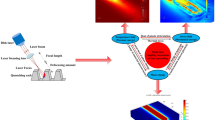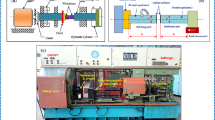Abstract
In spite of the existence of a well-developed realistic friction model, it has only been applied to the simple geometric problems, such as the axisymmetric and plane strain conditions, where the formulations of lubricant transport can be decomposed into two characteristic equations. Accordingly, a unified procedure of combining the current lubrication/friction model and finite element code of metal forming has been developed in this article for either steady or unsteady three-dimensional process including both axisymmetric and plane strain cases. In the part of the lubrication analysis, a finite element method is derived for the average Reynolds equation that is appropriated for 3-D metal forming process, and regardless of whether the tooling/workpiece surfaces are in contact or not. With regard to the theory of asperity contact, in addition to the well-known smoothing and roughening effects, significant deformation of asperities could be caused by the elastic microwedges on the tool surface. The availability of the new friction model was proved by a published problem and an axisymmetric stretch forming process was therefore adopted as a benchmark. Numerical results showed that the present analysis provides a good agreement with the measured strain distributions.











Similar content being viewed by others
Abbreviations
- A :
-
contact area ratio (fractional contact area)
- ∂A :
-
increasing rate of contact area ratio; dA/dt
- ∂A I :
-
component of ∂A induced by indentation effect
- ∂A M :
-
component of ∂A induced by microwedge effect
- ∂A R :
-
component of ∂A induced by roughening effect
- B :
-
geometric matrix
- C :
-
coefficient of microwedge model
- C R :
-
coefficient of surface roughening model
- dA 0 :
-
differential undeformed area
- D :
-
material matrix
- E t :
-
tangent modulus
- E w :
-
Young’s modulus of workpiece
- E I :
-
nondimensional strain rate of indentation mode
- f 1,f 2 :
-
functions of contact area ratio
- f h,f v :
-
force components per unit undeformed sheet area in the horizontal and vertical directions
- \(\mathop F\limits^{\bullet}\) :
-
nodal force rate
- h :
-
the nominal surface separation
- h t :
-
average film thickness (average surface separation)
- h 10 :
-
the initial film thickness
- \(\dot{h}_{\rm t}\) :
-
squeezing of film thickness, ∂h t/∂t
- H t :
-
nondimensional average film thickness (nondimensional average surface separation), h t /R q
- k :
-
shear strength of workpiece
- K :
-
strength coefficient of workpiece
- m :
-
index in microwedge model
- n :
-
strain hardening exponent
- N :
-
the shape function
- p p :
-
pressure on asperity peak
- p v :
-
lubricant pressure in the valley
- \(\bar{p}\) :
-
mean pressure
- Δp :
-
pressure difference, p p−p v
- ΔP :
-
nondimensional effective hardness, (p p−p v)/k
- \(\bar{p}\) :
-
nondimensional mean pressure, \(\bar{p}/k\)
- P v :
-
the nondimensional lubricant pressure
- Q :
-
outward flows
- R :
-
anisotropy parameter
- R q :
-
R.M.S. of surface roughness
- s :
-
sliding distance
- S :
-
nondimensional sliding distance, s/S m
- S m :
-
mean asperity spacing
- S p :
-
the fluidity matrix corresponding to pressure variation of lubricant film
- S U :
-
the fluidity matrix corresponding to film entrainment of lubricant
- S V :
-
the fluidity matrix corresponding to surface sliding of lubricant film
- \( S^{{\mathop h\limits^{\bullet}} _{\rm t}}\) :
-
the fluidity matrix corresponding to the squeezing action of lubricant film
- S * :
-
the nondimensional velocity
- t :
-
time
- t s :
-
thickness of workpiece
- \(\hat{t}\) :
-
the nondimensional time,
- U :
-
the average surface speed (the vector form)
- \(\hat{\user2{U}}\) :
-
the nondimensional average lubricant velocity, and
- \({\mathop U\limits^{\bullet}} _{\rm n}\) :
-
nodal velocity vector
- V :
-
the relative velocity of surfaces (the vector form)
- \(\hat{\user2{V}}\) :
-
the nondimensional relative sliding velocity
- η:
-
the viscosity of lubricant
- ξ:
-
initial distance from mid-surface
- Φ p :
-
the pressure flow factor
- Φ S :
-
the shear flow factor
- \(\varepsilon\) :
-
effective strain of workpiece
- \(\varepsilon_{1}\) ,\(\varepsilon_{2}\) :
-
principal logarithmic strains in the radial and circumferential directions
- \(\dot {\varepsilon }\) :
-
bulk strain rate of workpiece
- τ1,τ2 :
-
radial and circumferential components of Kirchhoff stress
- τa :
-
adhesion friction stress
- τe :
-
effective stress
- τf :
-
friction stress
- τh :
-
hydrodynamic friction stress
- τp :
-
plowing friction stress
- τy :
-
yield stress
- υ:
-
poisson’s ratio
References
Patir, N., Cheng, H.S.: An average flow model for determining effects of three-dimensional roughness on partial hydrodynamic lubrication. ASME J. Lub. Tech. 10l, 220–230 (1979)
Wilson, W.R.D., Wang, J.J.: Hydrodynamic lubrication in simple stretch forming processes. ASME J. Trib. 106, 70–77 (1984)
Sun, D.C., Chen, K.K., Nine, H.D.: Hydrodynamic lubrication in hemispherical punch stretch forming-modified theory and experimental validation. Int. J. Mech. Sci. 29, 761–776 (1987)
Wilson, W.R.D., Hector, L.G.: Hydrodynamic lubrication in axisymmetric stretch forming—part 1: theoretical analysis. ASME J. Trib. 113, 659–666 (1991)
Hsu, T.C., Wilson, W.R.D.: Refined models for hydrodynamic lubrication in axisymmetric stretch forming. ASME J. Trib. 116, 101–109 (1994)
Sa, C.Y., Wilson, W.R.D.: Full film lubrication of strip rolling. ASME J. Trib. 116, 569–576 (1994)
Yang, T.S.: Full film lubrication of deep drawing. Trib. Inter. 32, 89–96 (1999)
Yang, T.S., Lo, S.W.: A finite element analysis of full film lubricated metal forming process. Trib. Inter. 37, 591–598 (2004)
Lo, S.W.: A study on flow phenomena in mixed lubrication regime by porous medium model. ASME J. Trib. 37, 225–239 (1994)
Wilson, W.R.D., Marsault, N.: Partial hydrodynamic lubrication with large fractional contact areas. ASME J. Trib. 120, 16–20 (1998)
Majumdar, A., Bhushan, B.: Fractal model of elastic–plastic contact between rough surfaces. ASME J. Trib. 113, 1–11 (1991)
Ju, Y., Zheng, L.: A full numerical solution for the elastic contact of three-dimensional real rough surfaces. Wear 157, 151–161 (1992)
Horng, J.H.: An elliptic elastic–plastic asperity microcontact model for rough surfaces. ASME J. Trib. 120, 82–88 (1998)
Wilson, W.R.D., Sheu, S.: Real area of contact and boundary friction in metal forming. Int. J. Mech. Sci. 30, 475–489 (1988)
Sutcliffe, M.P.F.: Flattening of random rough surfaces in metal-forming processes. ASME J. Trib. 121, 433–440 (1999)
Lo, S.W., Tsai, S.D.: Real-time observation of the evolution of contact area under boundary lubrication in sliding contact. ASME J. Trib. 123, 229–238 (2002)
Lo, S.W., Yang, T.S.: A new mechanism of asperity flattening in sliding contact—the role of elastic tool microwedge. ASME J. Trib. 125, 713–719 (2003)
Tong, W., Hector, L.G., Weiland, H., Wieserman, L.F.: In-situ surface characterization of a binary aluminum alloy during tensile deformation. Scripta Mater. 36, 1339–1344 (1997)
Lee, W.: Surface roughening in metal forming processes. Ph.D. Thesis, Northwestern University (1996)
Lo, S.W., Horng, T.C.: Surface roughening and contact behavior in forming of aluminum sheet. ASME J. Trib. 121, 224–233 (1999)
Saha, P.K., Wilson, W.R.D.: Influence of plastic strain on friction in sheet metal forming. Wear 172, 167–173 (1994)
Saha, P.K., Shih, H.C., Wilson, W.R.D.: Modeling the influence of plastic strain on boundary friction in sheet metal forming. NAMRI Trans. 24, 173–180 (1996)
Lo, S.Y., Yang, T.S.: A microwedge model of sliding contact in boundary/mixed lubrication. Wear 261, 1163–1173 (2006)
Wilson, W.R.D., Hsu, T.C., Huang, X.B.: A realistic friction model for computer simulation of sheet metal forming process. ASME J. Eng. Indus. 117, 202–207 (1995)
Hsu, T.C., Lee, C.H.: Realistic friction modeling for simple upsetting. STLE Trib. Trans. 40, 367–473 (1997)
Hsu, T.C., Lee, C.H.: Refined fiction modeling for simple upsetting. ASME J. Manu. Sci. Eng. 119, 563–570 (1997)
Yang, T.S., Hsu, T.C.: Forming limit analysis of hemispherical punch stretching forming. J. Mate. Proc. Tech. 117, 32–36 (2001)
Yang, T.S., Lo, S.W.: Contact simulation for predicting surface topography in metal forming. Trib. Lett. 23, 121–129 (2006)
Acknowledgments
The author wishes to thank National Formosa University for the use of their facilities. The support from the National Science Council under grants NSC-93-2212-E-150-031 is also gratefully acknowledged.
Author information
Authors and Affiliations
Corresponding author
Rights and permissions
About this article
Cite this article
Yang, TS. A Refined Friction Modeling for Lubricated Metal Forming Process. Tribol Lett 27, 289–300 (2007). https://doi.org/10.1007/s11249-007-9233-x
Received:
Accepted:
Published:
Issue Date:
DOI: https://doi.org/10.1007/s11249-007-9233-x




